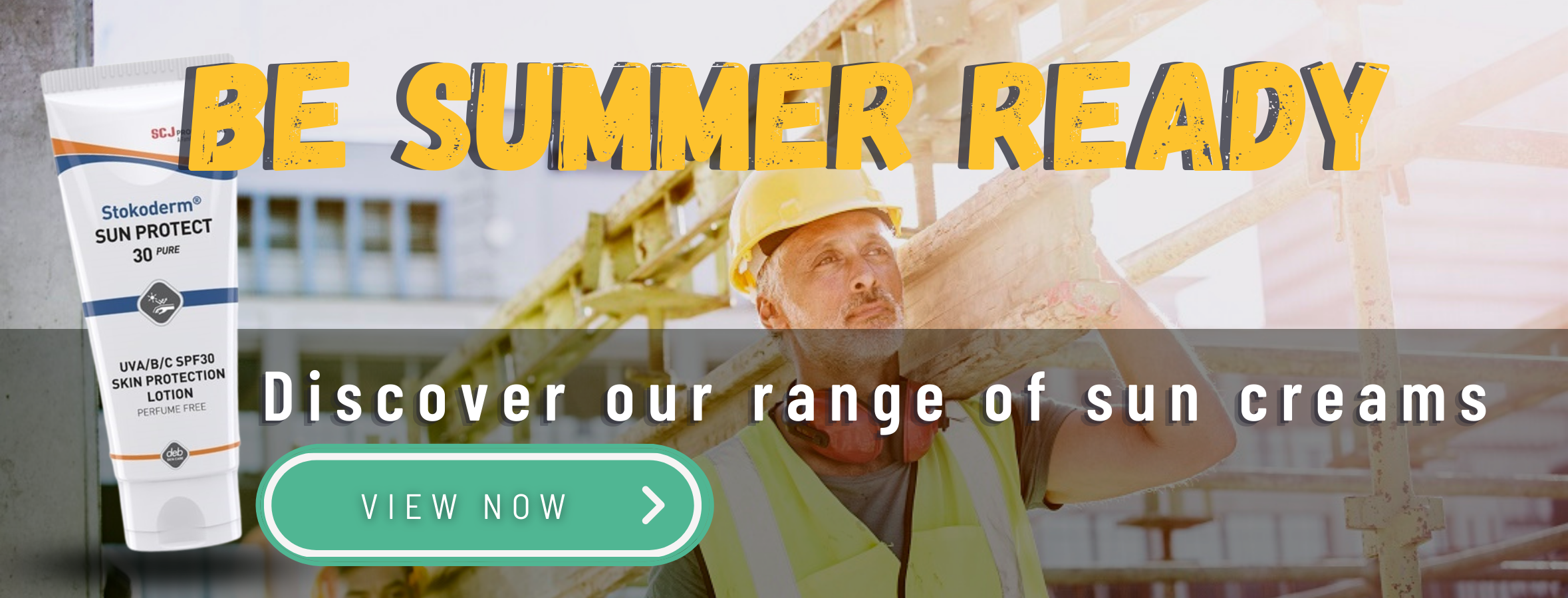How to protect your skin from the sun on site
How sun exposure affects you
Did you know that our bodies make vitamin D when we are exposed to natural sunlight.
Vitamin D is a nutrient that helps us absorb calcium and phosphate, which are important for strong bones, teeth, and muscles.
Simply put: being out in the sun provides warmth and light that enhances your general feeling of well-being.
However, excessive exposure to the sun rays can cause sunburn, leaving the skin red, itchy and tender.
Truth is, sunburn is not only a result of holidaying abroad, it can also be experienced in the UK even when it's cloudy.Further prolonged unprotected exposure can lead to skin cancer.
Approximately 90% of skin cancers are linked to exposure to ultraviolet radiation (UVR), so it is important to protect yourself from the sun.
Why does this matter?
Well, most skin cancers are entirely preventable by using sun cream with a high sun protection factor (SPF).
Are Ultraviolet (UV) Rays really that bad?
Overexposure to ultraviolet rays can damage the DNA in skin cells directly.
UVA rays have a longer wavelength which means they can affect cells deeper in the skin. UVA rays are associated with premature skin ageing.
While UVB rays have a shorter wavelength and damage the outermost layers of the skin and are associated with skin burning.
Although, both UVA & UVB rays differ in how they affect the skin, they both can cause skin cancer from prolonged exposure to the sun.
Even on very cloudy days, 80% of UVA rays pass through clouds.
UVC rays though not as common as UVA & UVB rays due to being blocked by the ozone layer, can be artificially made from welding torches, special bacteria-killing light bulbs and mercury lamps.
Whilst UVC rays are not as dangerous as UVB or UVA rays in terms of skin cancer, they can still cause severe damage such as burn lesions and ulcers on the skin.
What is the UV index?
Now that we have established how UV rays affect our skin
it's important to know when they pose a threat.
The UV index measures the strength of the sun’s UV rays. The higher the UV index number, the greater your risk of sunburn and skin damage.
When the UV Index reaches 3 or higher, the sun is strong enough to cause sunburn, therefore sun cream with a minimum of SPF 15 should be applied.
It is important to always be aware of the UV Index number when you are out in the sun, even on cloudy days.
Check out the UV index in your area: UV index forecast

|
LOW: UV 1-2 |
MODERATE / HIGH: UV 3-7 |
VERY HIGH / EXTREME: UV 8-11+ |
|
• No protection required • You can safely stay outside |
• Protection required • Wear a shirt, a hat & sunglasses • Apply sun cream to exposed skin with a minimum of SPF 15 |
• Extra protection required • Apply sun cream to exposed skin with a minimum of SPF 30 |
Who are most at risk?
Sometimes it only takes one serious sunburn every two years to triple your risk of melanoma skin cancer, so it is important to protect yourself from the sun's harmful UV rays.
Skin cancer is the most common form of cancer in the UK.
Every year, over 100,000 new cases are diagnosed, which kills 2,500 Britons - that's 7 people every day.
You should take extra precautions in the sun:
-
If you have an outdoor occupation such as builders, farmers, gardener.
-
If you have suffered severe sunburn in the past, especially with blisters.
-
If you have lots of moles or freckles.
-
If you have fairer skin or are more susceptible to burning.
-
If you have a personal or family history of skin cancer.
To simply put, the more easily you get sunburnt, the more careful you need to be.
If your skin’s gone red, pink, itchy, or tender while out in sun, it is highly likely that it's a sunburn.
When to apply sun cream & best practices
We've all been there, you're probably thinking "I don't have time to put on suncream"
But in truth, it only takes a few minutes to effectively rub sun cream on exposed skin, and around 15-20 minutes for it to be full absorbed & activated.
Think about that for a minute.
For just 15 minutes out of your day, you can protect yourself from the sun's harmful UV rays and prevent skin cancer.
An average-sized adult should approximately use at least six full teaspoons of sun cream to cover the body. Half a teaspoon on each arm and the face/neck including the ears.
Follow these 5 tips to put into practice now:
-
If possible take a break from the heat by spending time in the shade, particularly during midday or between 11 am - 3 pm when the sun is at its strongest.
-
It's a good idea to reapply sun cream every 2 hours or more often if you're sweating or have contact with water.
-
Not applying enough can reduce the protective performance of the sun cream. If you’re concerned about not applying enough sun cream, consider using one with higher SPF
-
Following this simple shadow rule. If you look at your shadow and it’s shorter than you, that means the sun’s UV rays are strong. So if you are likely to be in the sunshine for a prolonged period of time, you should protect your skin and seek shade.
-
Consider wearing long sleeve shirts, long trousers, sunglasses and wide-brimmed hats to block more of the sun, especially when working outdoors especially if shaded areas are limited.
SPF Ratings 15, 30 and 50+
Selecting the correct sun cream with the correct SPF is important to ensure that you are safely protected from the sun's UV radiation, specifically UVB.
SPF ranges from 2 to 50+. SPF 15 is considered mild protection, 15-30 is considered moderate protection, and SPF 50+ is a high level of protection.
The letters "UVA" in a circle on a sun cream package indicates that it meets the EU standard for protection against UVA rays.
-
SPF 15 blocks 93% of UVB rays
-
SPF 30 blocks 97% of UVB rays
-
SPF 50 blocks 98% of UVB rays
People with fair hair and skin, light-coloured eyes, freckles and moles should opt for high protection sun cream of at least SPF 30
Those with more melanin (a natural pigment in our skin that helps to protect against sun damage) will have a darker skin complexion and more natural sun protection.
Because of this, it is often thought that those with darker skin need not apply sun cream, however this is not the case.
Although there is more melanin in the skin the UV rays can still cause damage, sun cream with at least SPF 15 should be applied to exposed skin
Summary
To sum up, enjoying the sun safely is important, especially during the summer months as it enhances your general feeling of well-being and helps your body produce Vitamin D.
Whether you're working outside, gardening, or having a picnic in the park, it's important to protect exposed skin with sun cream to prevent sunburns.
Check the forecasted UV index in your area to identify the strength of the UV rays as this allows you time to take steps to protect yourself against the sun's harmful rays.
If you are unable to check the UV index follow the 'shadow rule' if your shadow is shorter than your height it is highly likely that the sun’s UV rays are strong and are more likely to burn without sun cream.
An average of 15 to 20 minutes of unprotected sun exposure per day without skin reddening or burning is sufficient for most people to maintain healthy vitamin D levels.
If you plan on being in the sun for a longer period of time, be sure to wear protective clothing, seek shade and apply sun cream to any exposed skin.
Those who neglect to protect their skin when exposed to the sun, especially outdoor workers risk getting sunburns and increase the likelihood of developing skin cancer.


